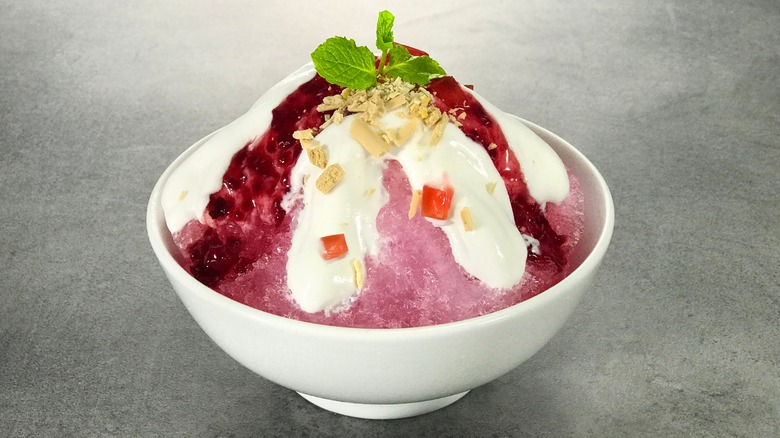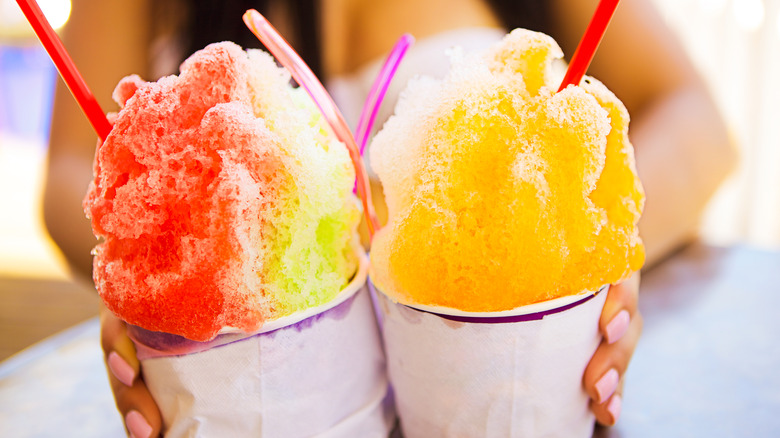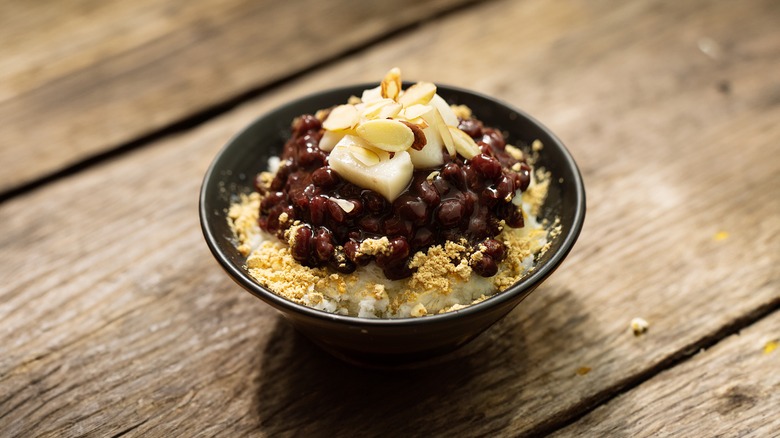The Main Difference Between Korean And Hawaiian Shaved Ice
When it's blisteringly hot outside, it can feel like the sun is sapping you dry. Drinking cold water is arguably the best way to stay cool and keep hydrated, but that can be boring. Instead, get your hydration the fun way by enjoying a delicious shaved ice treat.
Shaved ice comes in many forms worldwide, with two popular versions coming from Hawaii and South Korea. You're probably familiar with Hawaiian shave ice (there's no "d" when talking about this specific treat). Shave ice and snow cones, which use crushed ice, are among the most popular versions enjoyed in the United States. They're typically covered in colorful, fruity, sugar-loaded syrups with fun names such as tiger's blood and Bahama Mama.
The main difference between Hawaiian shave ice and Korean shaved ice — or bingsu — is that bingsu's ice is flavored before it's shaved. It's usually a mix of water, milk, and condensed milk, with flavorings such as matcha and chocolate sometimes added. This gives every bite a creamy, ice cream-like texture and flavor. Bingsu is then loaded up with delicious toppings such as boba, sweet red beans, and more condensed milk.
What to know about Hawaiian shave ice
Hawaiian shave ice's history is rooted in Japan. In the late 1800s and early 1900s, Japanese immigrants traveled to Hawaii for work, commonly finding it on sugar and pineapple plantations. They brought with them kakigōri, a shaved ice treat enjoyed by Japan's wealthy as early as the 9th century. When the workers started shaving ice with their tools on breaks and topping it with the fruits and sugars they had ample supply of, Hawaiian shave ice was born.
The key to Hawaiian shave ice is truly in the shaving. Unlike snowcones' loose and crunchy crushed ice, thin ice shavings create dense, fluffy layers that melt in your mouth. The density forces syrup to travel slowly through the layers, making each bite as flavorful as the last. In crushed ice, much of the syrup goes straight to the bottom.
Because of its simplicity, Hawaiian shave ice is a great treat to make at home. If you want the classic snowcone stand experience, you can use pre-made syrups. Or, if you make your own, start with canned fruit liquid as a base for flavorful syrup. Then, reduce it with some sugar until it's the right consistency. You could also start a quick and easy multi-fruit jam, stopping before it thickens to strain the pulp away and return the mixed juices to the pot for further reduction. Or leave the pulp in for a half-syrup, half-jam topping.
What to know about Korean shaved ice
Bingsu, like Hawaiian shave ice, is also deeply rooted in history and owes much of its modern form to Japan. While there are records of a bingsu-like treat called hwachae as early as the late 14th century, modern bingsu took on its kakigōri-like shape in the early 20th century during Japan's colonization of Korea. However, bingsu has firmly established its own identity separate from desserts that use plain ice by using a milk-and-water ice block. The milk also makes the already creamy texture of ice shavings that much creamier.
Because of this flavored base, you can top bingsu with a huge array of treats without worrying about how they affect the taste. Some collections of toppings are so common they've become their own named dish. Patbingsu's mix of sweet red bean paste, vanilla ice cream, and fruit is among the most popular, as is injeolmi bingsu's use of rice cakes and soybean powder.
If you want to shave this milk-and-water ice or regular ice, the easiest way is to use an at-home shaver. You can also use a blender for partly fluffy, partly crunchy ice. If you don't mind using some significant elbow grease, you can ignore machines entirely by hand-shaving the ice with a sharp knife or cheese grater. However you shave it, use large blocks that have thawed for about five minutes for the best results.


